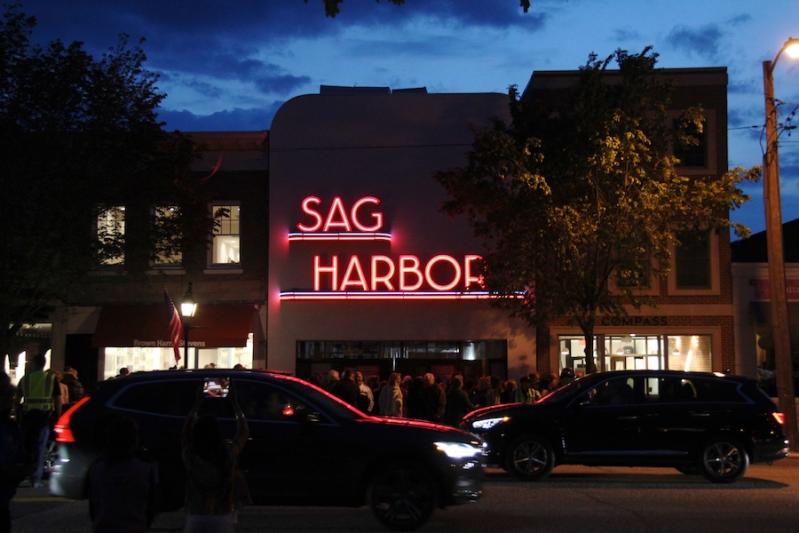On Saturday evening, a crowd gathered on Main Street in Sag Harbor to witness the ceremonial relighting of the iconic “Sag Harbor” sign on the recently restored facade of the Sag Harbor Cinema. This event marked the first time the sign had been lighted since the building was badly damaged by a fire in December 2016.Anticipation began to build around 7 as residents formed a cheery throng on the sidewalk in front of the theater — many toted cameras, and several were dressed in full “Sag Harbor” regalia, with caps and hoodies bearing the village’s name. Police officers in yellow vests redirected traffic to accommodate the large crowd, eventually closing the street completely as it grew, spilling down Washington Street. Everywhere children were climbing trees or perched atop shoulders, craning their necks to get a view of the action.An estimated 2,000 people turned out for the event, which was led by April Gornik, chairwoman of the Sag Harbor Cinema Arts Center’s board. Among those who spoke during the short introduction were New York State Assembly man Fred W. Thiele Jr., Southampton Town Councilman Tommy John Schiavoni, and Sag Harbor Mayor Sandra Schroeder. Also present were several members of the Sag Harbor Partnership, the nonprofit that purchased the building in 2018 with the intention of transforming it into a multiuse arts center.Just after 8, as the sun slid into the bay, Ms. Gornik led the crowd in a countdown that was quickly drowned out by enthusiastic applause and whistling as the sign flickered on to a triumphant red glow.“We have been waiting so long for this,” said Tracey Loggia, a Sag Harbor resident. “And it is overwhelming to see the outpouring of support from the community.”In a village characterized by fierce community pride and a commitment to historical preservation, the Sag Harbor Cinema has been, for many years, one of the most iconic and universally beloved landmarks. Designed in 1936 by John Eberson — a renowned architect responsible for more than 100 theaters across the country — it was built in a classically Art Deco style, with a curved marquee, red velvet carpeting, and a brass ticket counter.Over its 80 years of operation, tens of thousands of movies flickered across the screen of the single-theater cinema — many of them obscure art films, documentaries, and foreign titles that weren’t available elsewhere. It was, for many years, the only art-house cinema on the East End, attracting cinephiles and viewers who were interested in more than big blockbusters. Those who frequented the old theater reminisce fondly about its many idiosyncrasies — the damp dusty smell, sticky floors, creaky red seats, and perpetually stale popcorn. It seems everyone has a story about a time when he or she was the only person in the theater — or one of a handful — for a winter night screening. In recent decades, as Sag Harbor has grown in popularity and businesses have adapted to more modern clientele, the theater remained comfortingly anachronistic, its powder room and kitschy sconces capable of transporting viewers back to a sleepier era in the village’s history.For many, the cinema exemplified the kind of small-town character that makes Sag Harbor special. And the sign was a big part of that. “To see those glowing Sag Harbor marquee letters . . . lighting up the street, it was that old-time Main Street Americana, in a way that very few towns have anymore,” said Annette Hinkle, author of “Sag Harbor: 100 Years of Film in the Village.”The unique atmosphere of Sag Harbor, particularly Main Street, as a lasting artistic bastion of a simpler era, is something that the village and its residents have fought hard to maintain. In 2007, residents concerned about the proposed development of a CVS formed Save Sag Harbor, a grassroots effort to keep chain stores out of the village. The group was successful at preventing the CVS and has since fought several similar projects, advocated for protection of wetlands, and championed preservation of historical buildings in the village.It indicates something about the village’s commitment to upholding its identity that there are currently two separate nonprofits — the Sag Harbor Partnership and Save Sag Harbor — dedicated to community preservation within the 2.3-square-mile village.Some may recall that this is not, in fact, the first time Sag Harbor residents have rallied to save the famous sign. In 2004, following the theater’s attempt to dispose of the sign, which had fallen into disrepair, a group of residents led by Brenda Siemer and Joe Pintauro saved it from the junkyard, storing it for a time in a boat trailer, before raising money to have it refurbished.More than a decade later, on Dec. 16, 2016, as a fire of unknown origin burned a massive hole through Main Street, officials acted to save the sign from the flames. The fire itself was devastating, destroying buildings in the center of the business district, but the sign was spared. “The thought was that as long as the sign is okay, everything else can be rebuilt,” said Mr. Thiele. For many, the relighting is representative of the resilience of the village, heartening proof of the power of grassroots efforts like the Sag Harbor Partnership to make meaningful change.“It’s one of those magic moments that happens in a small town, when everyone comes together around a cause,” said Linley Pennebaker Hagen, a longtime resident. “Institutions like the movie theater are what make Sag Harbor what it is. It’s the heart and soul of the town.”The renovated cinema is slated to open later this year. The Sag Harbor Partnership intends to preserve much of the building’s character, while updating its facilities to include a second screen and rooftop terrace. The group is hoping to raise an additional $3 million to $4 million in donations over the summer to complete the project debt-free. Until then, the sign will continue to grace the theater’s facade, a beacon of what is to come.“We all know the feeling of driving into town after being away,” said Mr. Thiele, “and when you see the sign, you know you’re home.”Soon after the lighting was over, the road was reopened and the crowd began to disperse. By 9, the scene on Main Street had mostly returned to normal, save for a handful of people still lingering on the sidewalk in front of the theater, talking and catching up, their smiling faces illuminated in the warm red glow.
Villages

DarkSky Rep Slams Amagansett Lighting Plan
A plan to replace street lighting in Amagansett’s historic district had called for 46 to 50 “historical style” light fixtures. On Monday night, the plan drew a strong critique from New York State’s representative of DarkSky International.

Doctors Assail New Federal Hep B Vaccine Recs
Pediatricians on the South Fork were harshly critical of the federal Advisory Committee on Immunization Practices’ vote to recommend that pregnant women who test negative for hepatitis B should decide when or if their child will be vaccinated against the virus at birth.

Montauk Holiday Fair Grows
The fourth annual Magic of Montauk Holiday Fair, complete with Santa Claus, live reindeer, a hot cocoa contest, live music, and, for the first time, a holiday train, happens on Saturday and Sunday from 1 to 6 p.m. on the downtown green.
Your support for The East Hampton Star helps us deliver the news, arts, and community information you need. Whether you are an online subscriber, get the paper in the mail, delivered to your door in Manhattan, or are just passing through, every reader counts. We value you for being part of The Star family.
Your subscription to The Star does more than get you great arts, news, sports, and outdoors stories. It makes everything we do possible.

